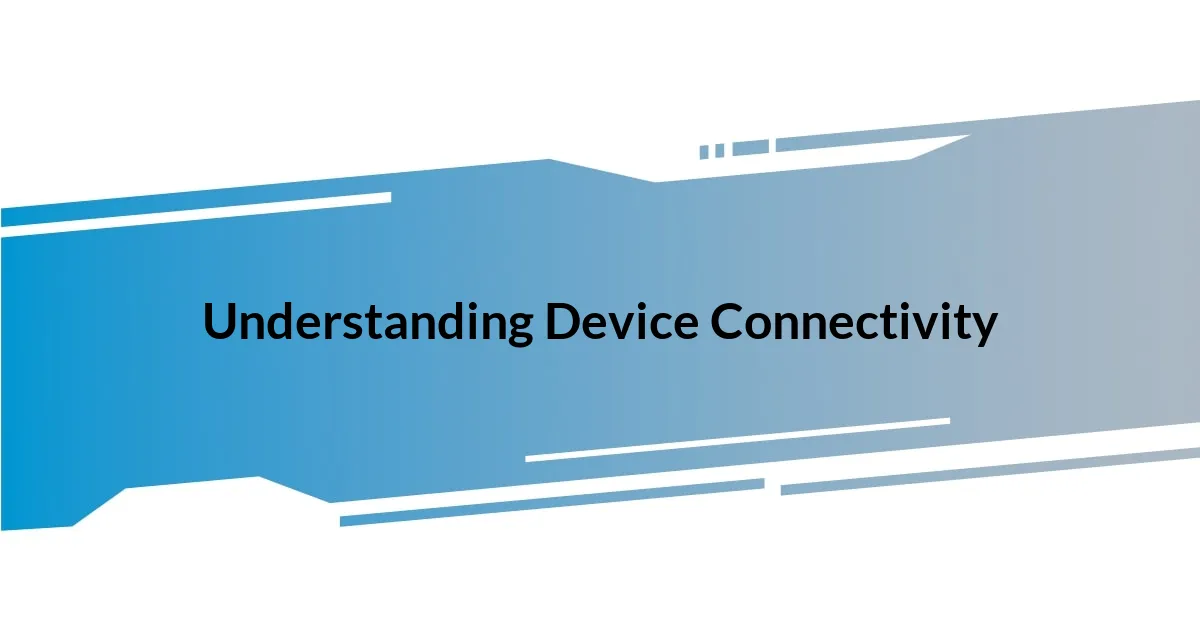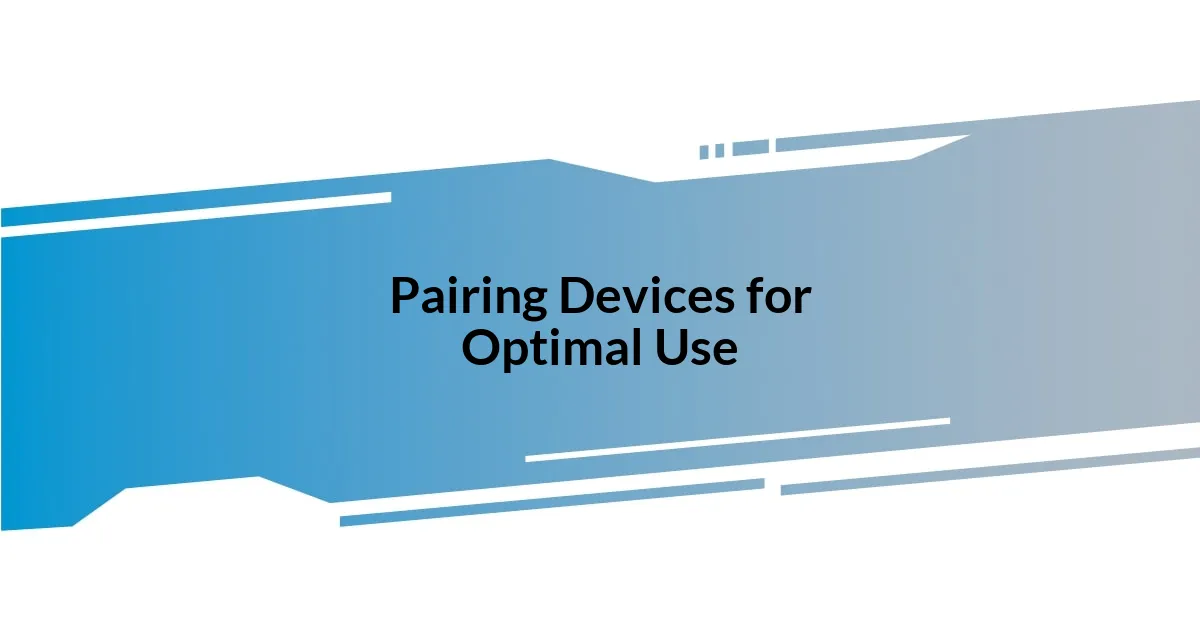Key takeaways:
- Device connectivity enhances daily life through various technologies like Bluetooth, Wi-Fi, and NFC, each suited for different tasks.
- Selecting compatible devices within the same ecosystem simplifies connections and improves user experience.
- Effective setup and troubleshooting methods, including updating firmware and checking connectivity, significantly reduce frustrations.
- Future trends such as 5G and AI promise to revolutionize device connectivity, making it faster and more intuitive.

Understanding Device Connectivity
When I think about device connectivity, I remember the first time I tried to sync my smartphone with my laptop. I felt that mix of excitement and anxiety, not knowing if everything would work smoothly. It’s fascinating how different devices can communicate, often in ways we don’t even realize, using protocols to translate signals into data that we can use.
Have you ever felt that rush of frustration when something just won’t connect? I certainly have. It’s often about understanding how Bluetooth, Wi-Fi, and even NFC (Near Field Communication) technologies work. Each of these methods has its strengths and weaknesses, depending on what you need at that moment. For instance, I’ve found that Bluetooth excels for short-range connections, which is perfect for my headphones while walking, but Wi-Fi is superior when I’m streaming a movie on my TV.
To me, exploring device connectivity feels like a puzzle that enhances our daily lives. Each interaction—whether it’s printing a document wirelessly or sharing files across platforms—brings a little thrill. Isn’t it incredible how just a few taps can bridge gaps between devices and simplify tasks that once felt insurmountable?

Choosing the Right Devices
Choosing the right devices is crucial for a seamless experience. I remember when I had to select a smart TV; I felt overwhelmed with options. After diving into specs and reviews, I realized that not only resolution and size matter, but also compatibility with my existing devices—having a TV that could easily connect with my sound system was a game-changer for movie nights.
In my experience, going for devices with similar ecosystems can simplify connectivity. For instance, I’ve integrated my iPhone with Apple Home products, allowing me to control lights and temperature with ease. It’s a satisfying feeling to walk into a room and have everything set up just right because I chose devices that played well together.
When evaluating options, I suggest considering your usage patterns as well. Do you need devices for work, entertainment, or smart home features? I’ve found that prioritizing my specific needs not only saves time but also offers a more enjoyable experience down the line. For instance, choosing a tablet that supports stylus input was transformative in my day-to-day note-taking routine.
| Device | Compatibility |
|---|---|
| Smart TVs | Check for support with streaming devices like Chromecast or Roku |
| Smart Speakers | Ensure they work with your phone’s assistant (Siri, Google Assistant) |

Setting Up Your Devices
Setting up devices can sometimes feel like an intricate dance, but the satisfaction that comes with each successful connection is worth the effort. I recall a weekend spent configuring my new printer, feeling that familiar blend of anticipation and irritation. When I finally got it linked wirelessly to my laptop, I couldn’t help but grin at the thought of printing without ever needing a cable. It’s those small victories that keep me eager to dive into tech challenges.
Here are some tips to ensure a smooth setup process:
- Read the Manuals: I can’t stress enough how helpful the setup guides can be. They often include troubleshooting tips that save time later on.
- Use Compatible Apps: For my smart home devices, utilizing the recommended apps made the entire setup seamless. They can reduce confusion significantly.
- Check Software Updates: Before connecting, I make it a point to update device firmware, which has resolved many compatibility issues for me.
- Connect to the Same Network: I once struggled to set up my smart bulb until I realized it was trying to connect to the guest Wi-Fi; being on the same network is crucial.
- Test Functionality: After setup, I always take a moment to test everything. There’s nothing quite like the satisfaction of seeing all devices interact flawlessly.
Taking the time to follow these steps can lead to a happier, stress-free experience when setting up your devices.

Pairing Devices for Optimal Use
Pairing devices can dramatically enhance your experience if done thoughtfully. I remember the exhilaration of finally connecting my wireless headphones to my laptop for the first time. The clarity of sound and the freedom of movement completely transformed how I enjoyed music while working. Have you ever had a moment like that where everything just clicked efficiently?
To get the most out of your devices, it’s essential to pay attention to the pairing process. When I paired my smartwatch with my smartphone, for example, I discovered how much more I could streamline my notifications and fitness tracking. It’s fascinating to see how small changes, like enabling notifications from certain apps, can positively impact daily habits.
Sometimes, all it takes is a simple restart to resolve pairing issues, or perhaps updating your devices to the latest firmware could make a world of difference. I’ve faced my share of frustrations when devices wouldn’t connect—only to find that an update was the solution I’d overlooked. Have you experienced that? With patience and a bit of troubleshooting, the satisfaction of seamless connectivity is absolutely worth it.

Troubleshooting Common Connectivity Issues
It’s all too familiar—your device just won’t connect, and frustration begins to set in. I remember a particular evening when my home Wi-Fi mysteriously dropped, leaving me grappling with a non-responsive streaming device. After a few deep breaths, I decided to reboot the router. Within moments, everything was back online, reminding me how often simple resets can save the day. Have you faced a connectivity hiccup that turned out to be an easy fix?
When troubleshooting, the first step I always take is to check the status indicators on my devices. For instance, I once had an issue with my Bluetooth speaker, which didn’t seem to be discoverable. A glance at the blinking light told me that it was actually in pairing mode all along, though I was convinced it was off. Being attentive to these details can uncover solutions rapidly—wouldn’t that save us both time and exasperation?
As I dive deeper into the troubleshooting process, I often find myself looking up specific error codes online. There was a time when my printer displayed one that left me scratching my head. With a quick web search, I discovered it referred to a minor paper jam I missed. This taught me the value of patience and resourcefulness; taking a moment to search can often illuminate the path forward. Have you ever underestimated the power of a simple internet search during a tech struggle?

Enhancing Your Connectivity Experience
To elevate your connectivity experience, integrating devices is just the beginning. I vividly recall the joy I felt when I synced my tablet with my smart home system; I could control lights, music, and the thermostat all from one screen. It was like having my own command center, and I realized how a little effort into integration could lead to so much convenience. Have you ever imagined how seamless control over your environment could simplify your day-to-day life?
Another key to enhancing connectivity lies in establishing reliable connections. A few months back, I upgraded my router, and the difference was astounding. Streaming videos and gaming online became an absolute breeze, with minimal lag. It impressed upon me just how essential it is to invest in good-quality equipment. Isn’t it fascinating how the right tools can transform your entire digital landscape?
One tip I’ve learned is to explore all the features of your connected devices. For instance, when I discovered my smart TV had screen mirroring capabilities, I was thrilled. Now, sharing photos from my phone during gatherings is a breeze, making family time more interactive and joyful. Have you taken the time to uncover the hidden features of your devices? Sometimes, I think we overlook these gems, yet they can significantly enrich our connectivity journey.

Future Trends in Device Connectivity
It’s intriguing to consider how emerging technologies will redefine device connectivity in the near future. Recently, I experimented with a smart home hub that promised effortless integration with various gadgets. As I sat back and watched them harmonize—a smart lock, lights, and speaker all communicating seamlessly—I realized how close we are to a truly integrated digital experience. Have you ever thought about how one centralized system could eliminate the juggling of multiple apps?
Looking ahead, the rise of 5G technology also fascinates me. I remember a recent road trip where my mobile hotspot struggled to keep up while I navigated and streamed music simultaneously. With 5G, that would no longer be an issue. The promise of faster speeds and greater capacity excites me, as it opens possibilities for connecting even more devices effortlessly. Could you imagine living in a world where buffering is a relic of the past?
I can’t help but wonder about the potential of artificial intelligence in streamlining connectivity. The other day, I encountered a voice assistant in my car that intuitively understood my preferences and started adjusting the temperature as soon as I got in. Such advancements hint at a future where our devices not only connect but also learn from us. Isn’t it incredible to think about how AI might enhance our interactions with technology, making them more personalized and responsive?